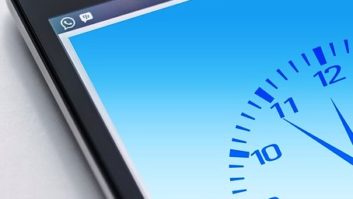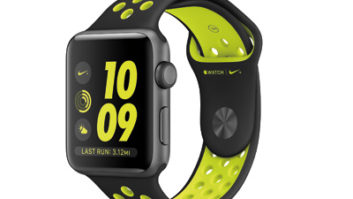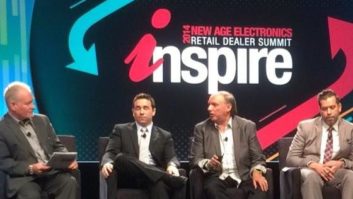TWICE: As cellphones evolve into multipurpose devices, what will be the impact on sales of dedicated devices? Will phones increasingly become a consumer’s main MP3 player?
Laikin: I believe MP3 players will eventually be a standard feature in wireless devices in the near future, just like color and cameras. The probability of a wireless device becoming consumer’s main MP3 player is high, and both forms of downloads (from PC and over-the-air) will drive the music-phone demand in the market. With audio quality and headsets becoming highly sophisticated, I don’t see why anyone would want to carry more than one device.
I think multipurpose converged devices are the future of the wireless device industry. With high-capacity memory cards on the rise and increasing memory size in the device itself, a converged device will be very capable of handling a variety of applications, features and functions. A converged smart device is a mini-computer in the palm of your hands. Different operating systems (such as Symbian, Windows Mobile, Linux and others) allow multiple applications to run effectively on these devices.
Cross: As the ability for a phone to handle gigabytes worth of music, a subset of consumers will look to their handset to serve the role of their main MP3 player, but conversely we believe there will always still be a segment of consumers who want a dedicated music device. We’ve seen the same thing happen with digital cameras related to the availability of higher quality camera phones.
While the music phone market is rapidly evolving and our products are widely recognized as solid “all-in-ones,” we believe there will continue to be a healthy market for dedicated devices as well.
Brad Duea, Napster: The ubiquitous cellphone will soon become most people’s MP3 player of choice. While research shows that consumers’ digital music collections are growing, still 82 percent of online adults with music collections have less than 1,000 songs on their MP3 player. With 1GB MicroSD cards going for around $40, and 2GB cards readily available with even larger capacities just around the corner, a cellphone can easily handle the few hundred songs that are in the portable music collections of most consumers.
Moreover, many folks are searching for ways to eliminate multiple devices if they can find a device that combines functionality, particularly if the multifunction device is easy to use, affordably priced and the user does not have to make a sacrifice on quality. That is exactly the case with the new music-enabled cellphones. The new Cingular Sync from Samsung is a sleek, thin phone that gives consumers one-click access to music, allowing them to enjoy subscription music content from Napster on their phone as well access Napster Mobile’s 2.5 million song library directly from their phone. The Sync is aggressively priced at $49.99.
Sohn: We believe the impact will be minimal as you have the phone for every day use of these functions and dedicated devices for when you want the optimal experience. The reason is that while phones can have high-quality functions across all areas, the most advanced features tend to start in dedicated devices and then move into cellphones. Digital photography is a great example, where phones are very popular for being able to take pictures wherever you go and at any time. But when the phone owner needs to have the best picture possible with the most advanced features possible, they turn to a dedicated camera.
The bottom line is that we are not simply improving the cellphone but creating the converged mobile device that we expect will be the center of consumer electronics for the foreseeable future.
TWICE: Which type of converged device do you think offers the most sales potential? For example, cellphone/MP3-players, satellite -radio/MP3 players, cellphones with navigation service?
Duea: The affordably priced music-enabled cellphone that can handle subscription content from Napster To Go and over-the-air content from Napster Mobile is the device with the most sales potential because it is a product that will be consumed by the masses.
First, music is something that appeals to most people and most people can find many songs they like in a catalog of over 2.5 million songs. Second, most consumers will find a cutting-edge, beautifully designed music-enabled cellphone attractive at a price of $49.99. Finally, Napster’s carrier partners are investing in marketing campaigns to let consumers understand what they can do with Napster and their phone, and they are also working closely with Napster and their handset manufacturers to make the process of consuming music on the phone easy. Carriers are providing consumers with phones that have more functionality and are doing so at lower price points than stand-alone players, due to subsidies and other marketing incentives.
TWICE: Will hybrid cellular/Wi-Fi phones make significant headway in 2007 as a wireless-data device or for doing double duty as a cellular phone and as a home VoIP phone?
Laikin: There has been a lot of discussion on FMC (Fixed-Mobile Convergence) in the past several quarters, and we have seen good progress made by equipment manufacturers. Cellular/Wi-Fi convergence is a reality and will gain traction both in voice and data in the next few years. Network integration and application development is helping drive this convergence in both the enterprise and consumer markets. These applications are becoming more demanding on the network’s abilities to serve the horizontal and vertical markets.
I believe we will see cellular/Wi-Fi converged devices from all the tier-one OEMs of wireless devices sooner than later. Interoperability and seamless hand-off between cellular and Wi-Fi network remains a concern and somewhat a limiting factor in the adoption of FMC. Organizations such as the Wi-Fi Alliance and others are involved in ironing out these issues and making FMC that much closer to mass commercialization.
Misuraca: It looks like we are already headed in that direction, but we are back to the very basics of landline services and what it offers. When you look at the overall numbers, you can clearly determine that this is a huge opportunity, but I think we are all waiting to see how it evolves as a category and whether or not major traction will be achieved.








